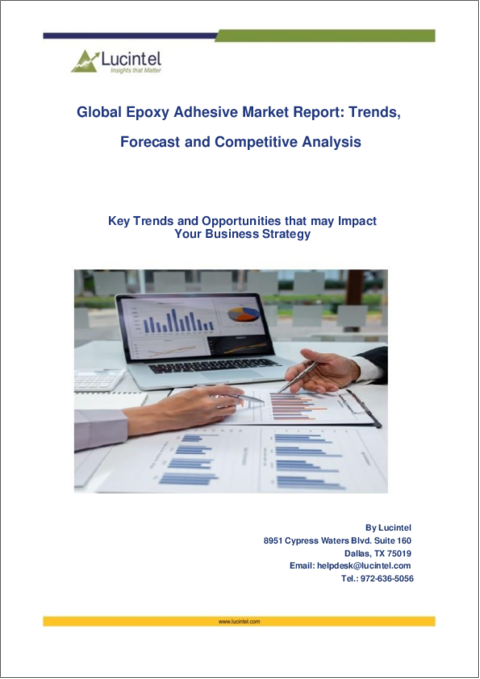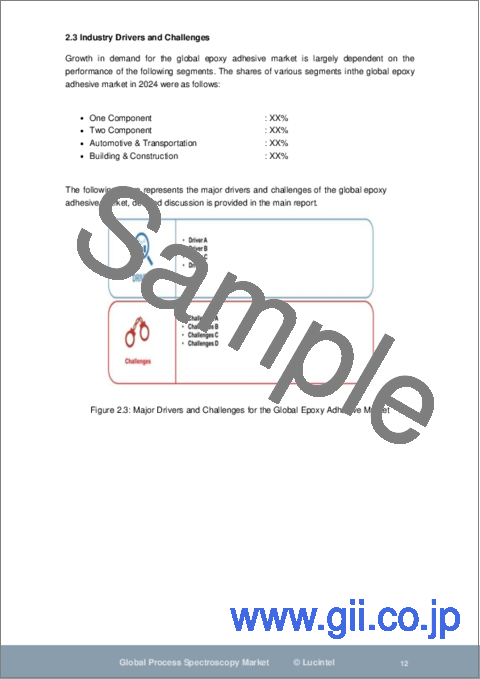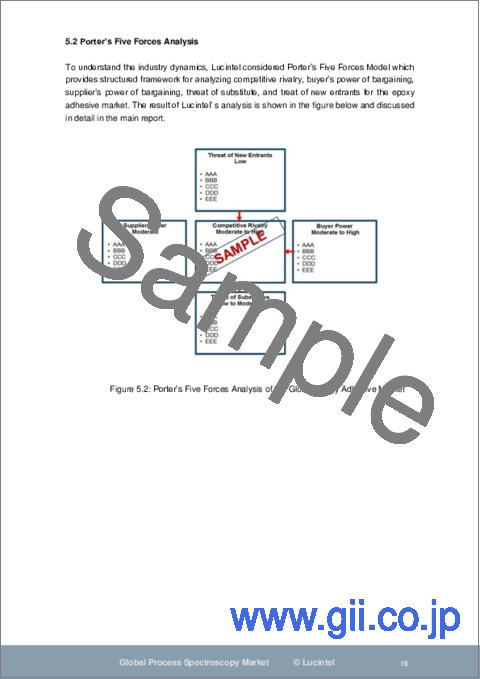|
|
市場調査レポート
商品コード
1610148
エポキシ接着剤市場レポート:2030年までの動向、予測、競合分析Epoxy Adhesive Market Report: Trends, Forecast and Competitive Analysis to 2030 |
||||||
カスタマイズ可能
適宜更新あり
|
|||||||
| エポキシ接着剤市場レポート:2030年までの動向、予測、競合分析 |
|
出版日: 2024年11月29日
発行: Lucintel
ページ情報: 英文 150 Pages
納期: 3営業日
|
全表示
- 概要
- 目次
エポキシ接着剤の動向と予測
世界のエポキシ接着剤市場の将来は、自動車・輸送、建築・建設、電力・エネルギー、電気・電子市場での機会により有望視されています。世界のエポキシ接着剤市場は、2024年から2030年までのCAGRが4.6%で、2030年までに推定118億米ドルに達すると予想されます。この市場の主な促進要因は、電気自動車(EV)の製造における支出の増加、自動車分野での軽量材料の使用、建設分野でのこれらの材料の使用の増加です。
- Lucintelの予測では、技術カテゴリーでは、振動や衝撃に対する耐性、熱サイクルに対する耐性などの利点から、2成分セグメントが予測期間中に最も高い成長を遂げる見込みです。
- 用途別では、自動車・輸送分野が引き続き最大です。
- 地域別では、急速な景気拡大と可処分所得の増加により、APACが予測期間中に最も高い成長を遂げると予想されます。
エポキシ接着剤市場の戦略的成長機会
エポキシ接着剤市場には、技術の進歩、業界の需要、応用分野の多様化に関連した戦略的成長の可能性がある多くの道があります。これらの機会を活用することで、ビジネスを成長させ、新たな市場を開拓することができます。
- 自動車産業の拡大:自動車市場はエポキシ接着剤の主要な成長分野であり、より軽量で堅牢な素材への需要の高まりがその原動力となっています。これには、高度な用途や性能向上のための自動車用接着剤の開発も含まれます。
- 建設部門の成長:建設セクターは、特に高い接着強度と耐久性を必要とする用途において、エポキシ接着剤に大きな市場を提供しています。建設関連用途の製品範囲を拡大することは、市場シェアを獲得するための効果的な戦略です。
- エレクトロニクスの進歩:エレクトロニクス産業の成長は、高性能な特性を持つ特殊エポキシ接着剤への需要を生み出しています。電子機器の組み立てや修理における接着剤の進化は、市場の成長を加速させる可能性が高いです。
- 持続可能性への取り組み:持続可能で環境に優しいエポキシ接着剤に注力することで、企業は規制を遵守し、市場のニーズを満たすことができます。VOC含有量を削減し、接着剤にリサイクル性を取り入れることが、この成長市場を支えています。
- 技術革新:樹脂化学とアプリケーション技術の発展を活用することで成長の機会があります。接着剤にスマートセンサーを組み込むことで、さまざまな新しい用途が開拓される可能性があります。
まとめると、これらの成長機会は技術革新、用途の拡大、環境問題への対応を通じてエポキシ接着剤市場を支えています。これらの機会を活用する企業は、競争力と将来性を高めることができます。
エポキシ接着剤市場促進要因・課題
エポキシ接着剤市場は、技術水準、経済、市場の規制などの要因によって駆動される決定要因と制約の公正なシェアを持つダイナミックなものです。市場を適切に管理するためには、これらの要因をよく理解する必要があります。
エポキシ接着剤市場を牽引する要因は以下の通りである:
- 技術の進歩:技術革新:接着剤の技術革新は、接着活動の更新による性能向上と使用期間の延長を通じて、市場の成長を刺激する可能性が高いです。高度な樹脂と硬化技術は、接着剤システムを強化します。
- 成長する最終用途産業:自動車、建設、エレクトロニクス産業の拡大により、高性能エポキシ接着剤の使用が増加しています。新たな用途が市場成長の新たな道を開いています。
- 持続可能性の動向:低VOCおよび水系接着剤の開発は、環境に優しく持続可能な製品に対する需要の結果です。持続可能な企業は規制を遵守し、環境意識の高い顧客にも対応できます。
- 経済発展:新興諸国の経済成長と工業化は、エポキシ接着剤の消費を増加させる。インフラと工業化への支出は市場の成長と発展を促進します。
- カスタマイズとイノベーション:特定の用途向けにカスタマイズされた接着剤は、創造性の必要性を煽る。特殊な配合に焦点を当てた幅広い開発範囲を持つ企業は、業界の明確なニーズを満たすことができ、より良い競争優位性を持つことができます。
エポキシ接着剤市場における課題は以下の通り:
- 規制の遵守:環境・安全規制の遵守は困難であり、遵守を達成するためには多大なコストと時間が必要となります。これは製品開発と市場参入に影響を与えます。
- 高い競合:エポキシ接着剤市場の競合は激しく、多くの企業が同様の製品を提供しています。市場シェアを獲得するには、創造性と独自性が不可欠です。
- 原材料コスト:原材料価格の変動は、生産コストと収益性に影響を与える可能性があります。製品の品質を維持しながら原材料コストを管理することは、メーカーにとって重要な課題です。
- 技術の複雑さ:最先端技術を接着剤の配合や用途に取り入れることは、コストと複雑さを伴う可能性があります。競合により、企業は研究と技術進歩への投資を余儀なくされます。
- サプライチェーンの混乱:原材料の入手可能性と製品を予定通りに生産できるかどうかは、国際的な要因に影響される可能性のあるサプライチェーンに左右されます。企業は、安定した製品供給を確保するために、サプライチェーンのリスクを軽減しなければならないです。
これらの促進要因・課題は、成長機会、市場力学、競争戦略を形成することにより、エポキシ接着剤市場に影響を与えます。これらの問題に効果的に対処することは、市場での成功と持続可能性を達成する上で極めて重要です。
目次
第1章 エグゼクティブサマリー
第2章 世界のエポキシ接着剤市場:市場力学
- イントロダクション、背景、分類
- サプライチェーン
- 業界の促進要因と課題
第3章 2018年から2030年までの市場動向と予測分析
- マクロ経済動向(2018年~2023年)と予測(2024年~2030年)
- 世界のエポキシ接着剤市場の動向(2018年~2023年)と予測(2024年~2030年)
- エポキシ接着剤の世界市場:技術別
- 1つのコンポーネント
- 2つのコンポーネント
- その他
- エポキシ接着剤の世界市場:用途別
- 自動車・輸送
- 建築・建設
- 電力とエネルギー
- 電気・電子
- その他
第4章 2018年から2030年までの地域別市場動向と予測分析
- 地域別のエポキシ接着剤市場
- 北米のエポキシ接着剤市場
- 欧州のエポキシ接着剤市場
- アジア太平洋のエポキシ接着剤市場
- その他地域のエポキシ接着剤市場
第5章 競合分析
- 製品ポートフォリオ分析
- 運用統合
- ポーターのファイブフォース分析
第6章 成長機会と戦略分析
- 成長機会分析
- 技術別世界のエポキシ接着剤市場の成長機会
- 用途別世界のエポキシ接着剤市場の成長機会
- 地域別の世界のエポキシ接着剤市場の成長機会
- 世界のエポキシ接着剤市場の新たな動向
- 戦略分析
- 新製品開発
- 世界のエポキシ接着剤市場の生産能力拡大
- 世界のエポキシ接着剤市場における合併、買収、合弁事業
- 認証とライセンシング
第7章 主要企業の企業プロファイル
- 3M
- Ashland
- Bostik
- Dow
- H.B. Fuller
- Henkel
- Mapei
- Parker Hannifin
- Permabond
- Sika
Epoxy Adhesive Trends and Forecast
The future of the global epoxy adhesive market looks promising with opportunities in the automotive & transportation, building & construction, power & energy, and electrical & electronics markets. The global epoxy adhesive market is expected to reach an estimated $11.8 billion by 2030 with a CAGR of 4.6% from 2024 to 2030. The major drivers for this market are increasing expenditures in the manufacture of electric vehicles (EVs), the use of lightweight materials in the automotive sector, and the growing use of these materials in the construction sector.
- Lucintel forecasts that, within the technology category, the two-component segment is expected to witness the highest growth over the forecast period due to benefits such as resistance to vibration and shock, as well as tolerance to thermal cycling.
- Within the application category, the automotive and transportation segment will remain the largest segment.
- In terms of regions, APAC is expected to witness the highest growth over the forecast period due to swift economic expansion and increasing disposable incomes.
Gain valuable insights for your business decisions with our comprehensive 150+ page report.
Emerging Trends in the Epoxy Adhesive Market
The increasing importance of end-use industries, as well as advancements in technology, are some attributes explaining the emerging trends in the epoxy adhesive market. These trends are defining the future of adhesive usage and their market positioning.
- Environment-Friendly: It has been observed that there is a growing market for low-VOC, recyclable epoxy adhesives. This scenario effectively addresses environmental concerns and complies with tightening regulations.
- High Strength Thermoplastic Resin: Improvements in resin chemistry facilitate the creation of better and stronger adhesive joints to satisfy even the most demanding environments. These improvements respond to the demands of emerging automotive and aerospace applications.
- Application-Based Adoption: The rise in demand for high-application-specific epoxy adhesives, such as electrical-grade and temperature-resistant formulations, has been noted. The use of specialized formulations is improving performance in different areas.
- Expanding Adoption of End-Use Industries: The growth of industries such as construction, automotive, and electronics is leading to increased consumption of epoxy adhesives. More applications in these sectors are driving innovations to improve adhesive performance and address market needs.
- Integration of Smart Technologies: The trend of incorporating smart technologies like sensors and IoT into adhesive applications is increasing. This innovation allows adhesives to be monitored and enhanced in real-time, improving efficiency.
These trends are revolutionizing the epoxy adhesive market by facilitating new developments, promoting green practices, and addressing the demands of various industries.
Recent Developments in the Epoxy Adhesive Market
Developments in the epoxy adhesive space provide insights into trends such as technology, sustainability vs. cost, and application versatility. These changes are supporting market expansion and helping shape future trends.
- Innovative Formulations: Advancements in the formulation chemistry of epoxy adhesives have increased performance, such as higher cure temperatures and reduced curing times. These innovations meet the needs of high-tech industries and extreme conditions.
- Sustainable Practices: The industry continues to adopt more sustainable practices, such as developing water-based and low-VOC epoxy adhesives. There is compliance with international ecological standards and demand from consumers for adherents that meet these standards.
- Expansion in Manufacturing: There has been an increase in investments toward setting up manufacturing facilities, which in turn enhances production capacity and meets corresponding demand. This expansion promotes market growth and improves supply chain efficiency.
- Technological Integration: The use of advanced technologies such as automation and digital monitoring is facilitating adhesive application processes. These technologies increase accuracy, reduce waste, and improve efficiency.
- Regional Market Growth: Emerging markets, especially in Asia-Pacific, are witnessing impressive growth. This growth is fueled by increased industrial activities and the growing use of epoxy adhesives across various sectors.
These developments are influencing the epoxy adhesive market by rolling out innovations, enhancing green initiatives, and supporting regional growth. They are helping to shape the future of the industry and drive market changes.
Strategic Growth Opportunities for Epoxy Adhesive Market
The epoxy adhesive market has many avenues for potential strategic growth related to technological advances, industry demand, and diversification of application areas. Capitalizing on these opportunities can grow businesses and open new markets.
- Automotive Industry Expansion: The automotive market is a key growing segment for epoxy adhesives, driven by the increasing demand for lighter and more robust materials. This includes the development of automotive adhesives for advanced applications and performance improvements.
- Construction Sector Growth: The construction sector offers considerable markets for epoxy adhesives, especially for applications requiring high bond strength and durability. Expanding the range of products for construction-related uses is an effective strategy for gaining market share.
- Electronics Advancements: The growth of the electronics industry creates a demand for specialty epoxy adhesives with high-performance characteristics. The evolution of adhesives in electronics assembly and repair is likely to accelerate market growth.
- Sustainability Initiatives: Focusing on sustainable, eco-friendly epoxy adhesives helps companies comply with regulations and meet market needs. Reducing VOC content and incorporating recyclability into adhesives supports this growing market.
- Technological Innovations: There are opportunities for growth by leveraging developments in resin chemistry and application technologies. The integration of smart sensors into adhesives could open up various new applications.
In summary, these growth opportunities are helping the epoxy adhesive market through innovation, expanded use, and addressing environmental concerns. Companies that capitalize on these opportunities can enhance their competitiveness and prospects.
Epoxy Adhesive Market Driver and Challenges
The epoxy adhesive market is a dynamic one with its fair share of determinants and constraints driven by factors such as the level of technology, the economy, and the regulations in place in that market. These factors should be well understood to manage the market properly.
The factors responsible for driving the epoxy adhesive market include:
- Technological Advancements: Adhesive innovation is likely to stimulate market growth through enhanced performance and extended use due to updated bonding activity. Advanced resins and curing technologies enhance adhesive systems.
- Growing End-Use Industries: The expanding automotive, construction, and electronics industries are increasing the use of high-performance epoxy adhesives. New applications are availing new avenues for growth in the market.
- Sustainability Trends: The development of low-VOC and waterborne adhesives is a result of the demand for environmentally friendly and sustainable products. Sustainable companies can comply with regulations and also cater to environmentally-conscious customers.
- Economic Development: The growing economies and industrialization in developing countries increase the consumption of epoxy adhesives. Spending on infrastructure and industrialization enhances the growth and development of the market.
- Customization and Innovation: Customized adhesives for specific applications fuel the need for creativity. Companies with a broader scope of development that focuses on specialized formulations can meet the distinct needs of the industry and have a better competitive advantage.
Challenges in the epoxy adhesive market are:
- Regulatory Compliance: Complying with environmental and safety regulations can be challenging, with significant costs and time required to achieve compliance. This impacts product development and market access.
- High Competition: The competition in the epoxy adhesive market is fierce, with many players offering similar products. Creativity and uniqueness are crucial for successfully capturing market share.
- Raw Material Costs: Fluctuations in raw material prices may affect production costs and profitability. Managing the cost of raw materials while maintaining product quality is a significant challenge for manufacturers.
- Technological Complexity: Incorporating cutting-edge technologies into adhesive formulations and applications can be costly and complex. Competition forces companies to invest in research and technological advancement.
- Supply Chain Disruptions: Availability of raw materials and the ability to produce products on schedule depend on the supply chain, which can be affected by international factors. Companies must mitigate supply chain risks to ensure consistent product delivery.
These drivers and challenges affect the epoxy adhesive market by shaping growth opportunities, market dynamics, and competitive strategies. Effectively addressing these issues is critical for achieving success and sustainability in the market.
List of Epoxy Adhesive Companies
Companies in the market compete on the basis of product quality offered. Major players in this market focus on expanding their manufacturing facilities, R&D investments, infrastructural development, and leverage integration opportunities across the value chain. through these strategies epoxy adhesive companies cater increasing demand, ensure competitive effectiveness, develop innovative products & technologies, reduce production costs, and expand their customer base. Some of the epoxy adhesive companies profiled in this report include-
- 3M
- Ashland
- Bostik
- Dow
- H.B. Fuller
- Henkel
- Mapei
- Parker Hannifin
- Permabond
- Sika
Epoxy Adhesive by Segment
The study includes a forecast for the global epoxy adhesive by technology, application, and region.
Epoxy Adhesive Market by Technology [Analysis by Value from 2018 to 2030]:
- One Component
- Two Component
- Others
Epoxy Adhesive Market by Application [Analysis by Value from 2018 to 2030]:
- Automotive & Transportation
- Building & Construction
- Power & Energy
- Electrical & Electronics
- Others
Epoxy Adhesive Market by Region [Analysis by Value from 2018 to 2030]:
- North America
- Europe
- Asia Pacific
- The Rest of the World
Country Wise Outlook for the Epoxy Adhesive Market
Major players in the market are expanding their operations and forming strategic partnerships to strengthen their positions. The following highlights recent developments by major epoxy adhesive producers in key regions: the USA, China, India, Japan, and Germany.
- United States: Increased demand in the automotive and aeronautics sectors is benefiting the U.S. market. New developments in adhesive formulations are improving product performance and durability, while policy reforms are supporting the use of eco-friendly solutions.
- China: China's epoxy adhesive market is experiencing robust growth due to rapid expansion in its construction and electronics industries. Innovations in resin technology and the expansion of adhesive production capacity are meeting the growing demand for high-performance adhesives.
- Germany: In Germany, the trend is the creation of eco-friendly, heat-resistant epoxy adhesives. Pressure from regulations and consumer preferences is shifting the market toward greener alternatives in various industries.
- India: Epoxy adhesive consumption is rising in India, with the construction and automotive sectors being major contributors. The market is evolving with enhanced manufacturing capabilities and new technologies to serve the domestic market.
- Japan: In Japan, new types of specialty epoxy adhesives for electronics and other high-tech applications are being developed. The growing importance of efficient adhesive utilization has driven the development of adhesives with improved reliability and performance.
Features of the Global Epoxy Adhesive Market
Market Size Estimates: Epoxy adhesive market size estimation in terms of value ($B).
Trend and Forecast Analysis: Market trends (2018 to 2023) and forecasts (2024 to 2030) by various segments and regions.
Segmentation Analysis: Epoxy adhesive market size by technology , application, and region in terms of value ($B).
Regional Analysis: Epoxy adhesive market breakdown by North America, Europe, Asia Pacific, and Rest of the World.
Growth Opportunities: Analysis of growth opportunities in different technology , application, and regions for the epoxy adhesive market.
Strategic Analysis: This includes M&A, new product development, and competitive landscape of the epoxy adhesive market.
Analysis of competitive intensity of the industry based on Porter's Five Forces model.
If you are looking to expand your business in this or adjacent markets, then contact us. We have done hundreds of strategic consulting projects in market entry, opportunity screening, due diligence, supply chain analysis, M & A, and more.
This report answers following 11 key questions:
- Q.1. What are some of the most promising, high-growth opportunities for the epoxy adhesive market by technology (one component, two component, and others), application (automotive & transportation, building & construction, power & energy, electrical & electronics, and others), and region (North America, Europe, Asia Pacific, and the Rest of the World)?
- Q.2. Which segments will grow at a faster pace and why?
- Q.3. Which region will grow at a faster pace and why?
- Q.4. What are the key factors affecting market dynamics? What are the key challenges and business risks in this market?
- Q.5. What are the business risks and competitive threats in this market?
- Q.6. What are the emerging trends in this market and the reasons behind them?
- Q.7. What are some of the changing demands of customers in the market?
- Q.8. What are the new developments in the market? Which companies are leading these developments?
- Q.9. Who are the major players in this market? What strategic initiatives are key players pursuing for business growth?
- Q.10. What are some of the competing products in this market and how big of a threat do they pose for loss of market share by material or product substitution?
- Q.11. What M&A activity has occurred in the last 5 years and what has its impact been on the industry?
Table of Contents
1. Executive Summary
2. Global Epoxy Adhesive Market : Market Dynamics
- 2.1: Introduction, Background, and Classifications
- 2.2: Supply Chain
- 2.3: Industry Drivers and Challenges
3. Market Trends and Forecast Analysis from 2018 to 2030
- 3.1. Macroeconomic Trends (2018-2023) and Forecast (2024-2030)
- 3.2. Global Epoxy Adhesive Market Trends (2018-2023) and Forecast (2024-2030)
- 3.3: Global Epoxy Adhesive Market by Technology
- 3.3.1: One Component
- 3.3.2: Two Component
- 3.3.3: Others
- 3.4: Global Epoxy Adhesive Market by Application
- 3.4.1: Automotive & Transportation
- 3.4.2: Building & Construction
- 3.4.3: Power & Energy
- 3.4.4: Electrical & Electronics
- 3.4.5: Others
4. Market Trends and Forecast Analysis by Region from 2018 to 2030
- 4.1: Global Epoxy Adhesive Market by Region
- 4.2: North American Epoxy Adhesive Market
- 4.2.1: North American Market by Technology: One Component, Two Component, and Others
- 4.2.2: North American Market by Application: Automotive & Transportation, Building & Construction, Power & Energy, Electrical & Electronics, and Others
- 4.3: European Epoxy Adhesive Market
- 4.3.1: European Market by Technology: One Component, Two Component, and Others
- 4.3.2: European Market by Application: Automotive & Transportation, Building & Construction, Power & Energy, Electrical & Electronics, and Others
- 4.4: APAC Epoxy Adhesive Market
- 4.4.1: APAC Market by Technology: One Component, Two Component, and Others
- 4.4.2: APAC Market by Application: Automotive & Transportation, Building & Construction, Power & Energy, Electrical & Electronics, and Others
- 4.5: ROW Epoxy Adhesive Market
- 4.5.1: ROW Market by Technology: One Component, Two Component, and Others
- 4.5.2: ROW Market by Application: Automotive & Transportation, Building & Construction, Power & Energy, Electrical & Electronics, and Others
5. Competitor Analysis
- 5.1: Product Portfolio Analysis
- 5.2: Operational Integration
- 5.3: Porter's Five Forces Analysis
6. Growth Opportunities and Strategic Analysis
- 6.1: Growth Opportunity Analysis
- 6.1.1: Growth Opportunities for the Global Epoxy Adhesive Market by Technology
- 6.1.2: Growth Opportunities for the Global Epoxy Adhesive Market by Application
- 6.1.3: Growth Opportunities for the Global Epoxy Adhesive Market by Region
- 6.2: Emerging Trends in the Global Epoxy Adhesive Market
- 6.3: Strategic Analysis
- 6.3.1: New Product Development
- 6.3.2: Capacity Expansion of the Global Epoxy Adhesive Market
- 6.3.3: Mergers, Acquisitions, and Joint Ventures in the Global Epoxy Adhesive Market
- 6.3.4: Certification and Licensing
7. Company Profiles of Leading Players
- 7.1: 3M
- 7.2: Ashland
- 7.3: Bostik
- 7.4: Dow
- 7.5: H.B. Fuller
- 7.6: Henkel
- 7.7: Mapei
- 7.8: Parker Hannifin
- 7.9: Permabond
- 7.10: Sika





